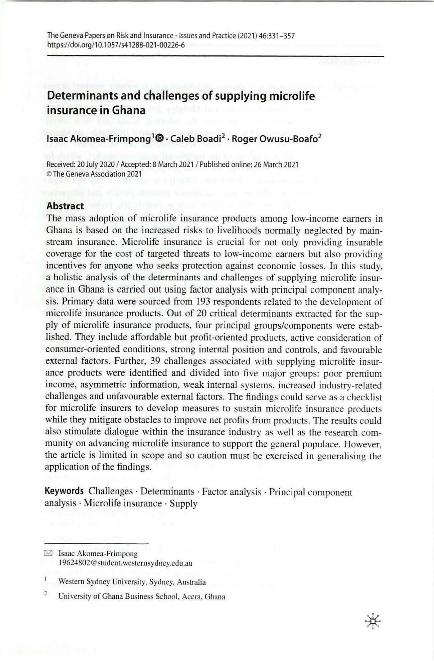Determinants and challenges of supplying microlife insurance in Ghana

Contenido multimedia no disponible por derechos de autor o por acceso restringido. Contacte con la institución para más información.
| Tag | 1 | 2 | Value |
|---|---|---|---|
| LDR | 00000cab a2200000 4500 | ||
| 001 | MAP20210031724 | ||
| 003 | MAP | ||
| 005 | 20220911201346.0 | ||
| 008 | 211103e2021 esp|||p |0|||b|spa d | ||
| 040 | $aMAP$bspa$dMAP | ||
| 084 | $a341 | ||
| 100 | $0MAPA20210035029$aAkomea-Frimpong, Isaac | ||
| 245 | 1 | 0 | $aDeterminants and challenges of supplying microlife insurance in Ghana$cIsaac Akomea-Frimpong, Caleb Boadi, Roger Owusu-Boafo |
| 520 | $aThe mass adoption of microlife insurance products among low-income earners in Ghana is based on the increased risks to livelihoods normally neglected by mainstream insurance. Microlife insurance is crucial for not only providing insurable coverage for the cost of targeted threats to low-income earners but also providing incentives for anyone who seeks protection against economic losses. In this study, a holistic analysis of the determinants and challenges of supplying microlife insurance in Ghana is carried out using factor analysis with principal component analysis. Primary data were sourced from 193 respondents related to the development of microlife insurance products. Out of 20 critical determinants extracted for the supply of microlife insurance products, four principal groups/components were established. They include affordable but profit-oriented products, active consideration of consumer-oriented conditions, strong internal position and controls, and favourable external factors. Further, 39 challenges associated with supplying microlife insurance products were identified and divided into five major groups: poor premium income, asymmetric information, weak internal systems, increased industry-related challenges and unfavourable external factors. The findings could serve as a checklist for microlife insurers to develop measures to sustain microlife insurance products while they mitigate obstacles to improve net profits from products. The results could also stimulate dialogue within the insurance industry as well as the research community on advancing microlife insurance to support the general populace. However, the article is limited in scope and so caution must be exercised in generalising the application of the findings. | ||
| 650 | 4 | $0MAPA20080586294$aMercado de seguros | |
| 650 | 4 | $0MAPA20080563394$aMicroseguros | |
| 650 | 4 | $0MAPA20080598358$aProductos de seguros | |
| 650 | 4 | $0MAPA20080570590$aSeguro de vida | |
| 651 | 1 | $0MAPA20090034464$aÁfrica | |
| 700 | 1 | $0MAPA20210035036$aBoadi, Caleb | |
| 700 | 1 | $0MAPA20210035043$aOwusu-Boafo, Roger | |
| 773 | 0 | $wMAP20077100215$g01/07/2021 Volumen 46 Número 3 - julio 2021 , p. 331-357$x1018-5895$tGeneva papers on risk and insurance : issues and practice$dGeneva : The Geneva Association, 1976- |

